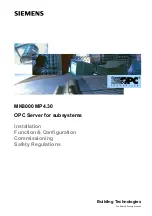
Installation
13
Building Technologies
048_DMS_MK8000_ICC_MP4.30_A6V10062407_a_en
Fire Safety & Security Products
06.2010
–
Reboot
–
Uninstall MSDE
–
Reboot
–
Delete the MSDE folder
, typically C:\Program Files\Microsoft SQL Server
–
Install SiPass
–
Re-install MK8000
See also the installation checklist in section
Error! Reference source not
found.
at p.
Error! Bookmark not defined.
.
Windows Vista
includes several new features. Among them, two have a signifi-
cant impact on the MM8000 operations. Namely:
–
UAC security
–
Virtualization of program files and registry entries
1) The
UAC (User Account Control)
is a security-related feature that is enabled
by default in Window Vista. The UAC main goal is to reduce the risk of unde-
tected attacks to the operating system by prompting users to ensure they are
authorized and want to perform a potentially harmful action.
When UAC is enabled, upon launching applications requiring administration privi-
leges, standard users are prompted to enter an administration password, and
even administrators must give an explicit consent through a UAC prompt to con-
firm they really intend to start the application.
The software applications that require administration privileges and fall
under User Account Control are identified by an icon that includes a
shield like:
Typically, the manual UAC
confirmation must be provided for
MM8000 tool applications
(Composer, PAKmanager and other
utilities): when prompted (see im-
age), just click Continue. If you do
not have administration rights, you
also have to enter an administrator
password.
Be informed that this is perfectly normal and is only necessary when the program
tool is started for the very first time.
Alternatively, you may want to disable UAC and let the PC behaves as with Win-
dows XP. You can do that in the Control Panel:
–
Select:
Start
Settings
Control Panel
–
In the Search box on the top right of the screen, type in “user account con-
trol”
The link for "Turn User Account Control (UAC) on or off" appears
–
Click on the link
The "Turn User Account Control (UAC) on or off" page appears
–
Uncheck the “Use User Account Control (UAC)…” option
–
Click OK and restart the PC
2)
Windows Vista Virtualization
creates a "per user" copy of system folders and
registry keys and then redirects successive data operations. For example, assum-
ing that an application requiring UAC permissions writes to a system location,
such as to the %programfiles% folder, Windows Vista redirects write operations
and read operations to a user-specific location in the user’s profile folder. Registry




























